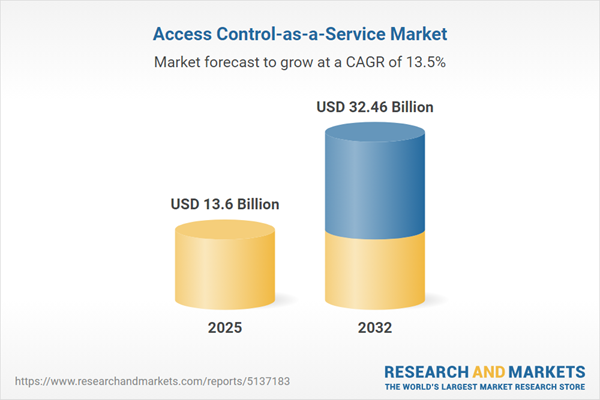Speak directly to the analyst to clarify any post sales queries you may have.
The Access Control-as-a-Service Market is transforming how enterprises secure digital identities and govern access in a rapidly advancing, cloud-centric environment. Senior decision-makers now face a diverse set of adoption drivers, compliance requirements, and innovation imperatives that are critical for risk mitigation and organizational resilience.
Market Snapshot: Access Control-as-a-Service Market Growth and Outlook
The Access Control-as-a-Service Market grew from USD 11.78 billion in 2024 to USD 13.60 billion in 2025. It is expected to continue growing at a CAGR of 13.49%, reaching USD 32.46 billion by 2032. These robust figures reflect both the acceleration of cloud adoption and the rising need for centralized, scalable security solutions across global enterprises, underscoring strong demand for adaptable access management frameworks.
Scope & Segmentation
- Model Types: Attribute-Based, Discretionary, Identity-Based, Mandatory, and Role-Based Access Controls are evaluated, focusing on attribute evaluation, ownership-based control, credential authentication, security clearance, and role authorization.
- Service Types: Hosted, Hybrid, and Managed services address varying needs for customization, control, and provider accountability.
- Authentication Models: Multi-factor authentication—covering two-factor and three-factor options—as well as single-factor alternatives, support diverse assurance levels.
- Access Points: Mobile applications, responsive web, biometric systems, card readers, browser extensions, and web portals demonstrate the breadth of user and device interaction scenarios.
- Organization Size: Solutions tailored for both large enterprises and small to medium businesses, supporting different deployment cadences and feature requirements.
- Deployment Models: Hybrid cloud, private cloud, and public cloud options provide flexibility for IT architects.
- End-User Sectors: Aerospace & Defense, Automotive & Transportation, Banking and Financial Services, Building & Real Estate, Consumer Goods & Retail, Education, Energy & Utilities, Government, Healthcare & Life Sciences, Information Technology, Manufacturing, Media & Entertainment, Travel & Hospitality.
- Geographic Coverage: Detailed analysis across Americas (North America, Latin America), Europe, Middle East & Africa, and Asia-Pacific including major economies such as the United States, Germany, China, and India.
- Key Companies: Competitive profiling and development tracking for vendors such as Acre Security, Assa Abloy AB, Brivo Inc., Cisco Systems, IBM, Honeywell, Microsoft Corporation, Oracle Corporation, and Palo Alto Networks.
Key Takeaways: Strategic Insights for Senior Decision-Makers
- Access management is shifting from isolated, on-premises deployments toward cloud-based, service-oriented architectures, optimizing scalability and accelerating threat response across distributed enterprises.
- Zero trust frameworks and context-aware policies are now table stakes, as leaders work to safeguard user identities, devices, and resources through dynamic, policy-driven controls.
- AI and machine learning integrations enable organizations to anticipate anomalies, remediate risks in real time, and evolve from static authentication to contextual, risk-based decision-making models.
- Vertical-specific needs drive demand for tailored integrations and compliance features—especially in regulated industries like financial services, healthcare, and government—requiring granular auditability and transparent reporting.
- Service model flexibility, from hosted to fully managed, gives IT and security leaders the control required to align access deployments with their organization’s unique operational pace and risk appetite.
Tariff Impact: U.S. Policy Shaping the Global Supply Chain
United States tariff policies introduced in 2025 have pressed enterprises to reevaluate hardware and support sourcing strategies. These measures intensify capital expenditures, especially for import-dependent physical access systems, prompting a clear shift toward software-centric and cloud-native alternatives. Adopting managed services helps mitigate pricing volatility, supports business continuity, and encourages innovation in authentication technologies that reduce reliance on specialized imported components.
Methodology & Data Sources
This research draws upon structured interviews with senior executives, security architects, and industry leaders, complemented by validated secondary sources from policy documentation, vendor reports, and regulatory analysis. Cross-verification and triangulation ensure objective, actionable insights, with every fact subjected to editorial rigor for clarity and accuracy.
Why This Report Matters
- Enables executives to anticipate shifts in access management, compliance, and technology adoption, informing robust risk strategies and secure digital transformation.
- Provides a nuanced framework for evaluating provider differentiation, competitive moves, and best-fit deployment options across key verticals and regions.
- Delivers clear, actionable recommendations to guide strategic investment, optimize security posture, and achieve lasting value from Access Control-as-a-Service initiatives.
Conclusion
This report offers a comprehensive, executive-focused analysis of the Access Control-as-a-Service Market, helping leaders make informed choices to build resilient, future-ready security ecosystems.
Additional Product Information:
- Purchase of this report includes 1 year online access with quarterly updates.
- This report can be updated on request. Please contact our Customer Experience team using the Ask a Question widget on our website.
Table of Contents
3. Executive Summary
4. Market Overview
7. Cumulative Impact of Artificial Intelligence 2025
Companies Mentioned
The companies profiled in this Access Control-as-a-Service market report include:- Acre Security
- Allegion Plc
- Allied Universal
- Assa Abloy AB
- Brivo Inc.
- Broadcom Inc.
- Cisco Systems, Inc.
- Cloudastructure Inc.
- Datawatch Systems, Inc.
- Delinea Inc.
- dormakaba Group
- DSX Access Systems, Inc
- Forcefield
- Genetec Inc.
- Honeywell International Inc.
- IDENTIV, INC.
- International Business Machines Corporation
- Johnson Controls International plc
- Kastle Systems
- Kisi Inc.
- M3T Corporation
- Microsoft Corporation
- Motorola Solutions, Inc.
- Oracle Corporation
- Palo Alto Networks, Inc.
- Robert Bosch GmbH
- SALTO Systems, S.L.
- Securitas Technology
- ServiceNow, Inc.
- Spica International d. o. o.
- Tata Consultancy Services Limited
- Telcred
- Thales Group
- Vector Security, Inc.
- Zhejiang Dahua Technology Co., Ltd.
Table Information
| Report Attribute | Details |
|---|---|
| No. of Pages | 193 |
| Published | November 2025 |
| Forecast Period | 2025 - 2032 |
| Estimated Market Value ( USD | $ 13.6 Billion |
| Forecasted Market Value ( USD | $ 32.46 Billion |
| Compound Annual Growth Rate | 13.4% |
| Regions Covered | Global |
| No. of Companies Mentioned | 36 |









